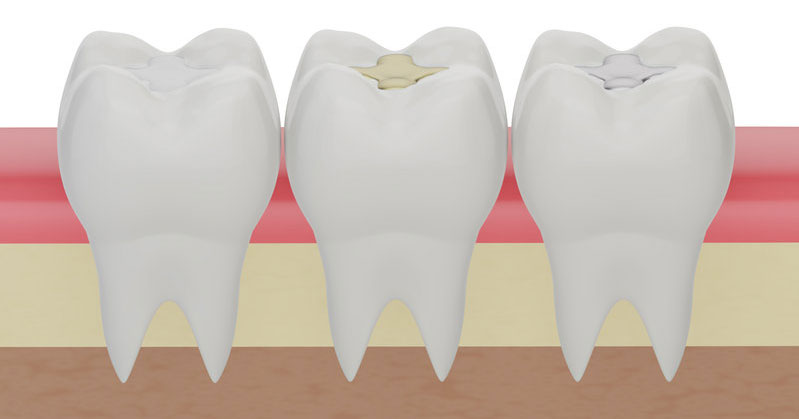When a tooth is decayed or damaged it is brought back to its normal shape and function by removing the decay and replacing the lost tooth material.
The dentist cleans out the decay and replaces the missing tooth material with dental fillings, so that the functionality and shape of the teeth are restored.
When are dental fillings used?
There are many dental issues for which dental fillings are used.
Four of the most common are the following.
1, Tooth decay
The tooth has decayed and there is a cavity. The kind of filling required to fill the cavity depends on the extent and location of the decay.
2, Cracked tooth
Cracking of the tooth happens more often than we think.
Cracks could appear either due to grinding or clenching the teeth. Biting into crunchy or hard substances also can cause cracks.
If the cracks are discovered early then they can be sealed off with a sealant to prevent further damage. But if it is a little wide, then it is treated like a cavity.
All dead and decayed dental matter are cleaned out, and a filling is used to replace the missing tooth structure. If the crack is very extensive then a crown may need to be used.
3, Fracture or chipping
There is fracture or chipping of the tooth. This usually happens due to injury or accident. Depending on the extent and the location of the fracture, a filling or restoration will be done for rebuilding the tooth shape.
4, Replacement filling
Replacing an old or a broken filling is another reason for a undergoing a dental filling procedure.
You must remember that dental fillings are not permanent. They do undergo wear and tear. The materials also shrink due to temperature variation. So you may need to replace the filling when they are worn down.
What are the different dental filling materials available?
Dental fillings can be either direct or indirect.
Indirect fillings or restorations are when the restoration is fabricated outside the mouth and then placed in the area where the tissue is missing. This is referred to as inlay or onlay depending on the type of fabrication.
Most often a filling refers to placing a soft pliable material into a tooth which is prepared by eliminating all the decay and making sure that only healthy tooth material is left. This material is then hardened. The biggest advantage here is that it is a quick procedure and a variety of different filling options are available to choose from.
The material is chosen depending on the location and severity of the cavity. Various available materials are as follows.
Cast gold fillings
It is durable, and lasts for 10-15 years. There is no corrosion, so the filling does not turn black or react with the other chemicals in the mouth. It is very strong and can take a high chewing load. But aesthetically the look may not very good, unless you are specifically going for that look.
The disadvantage of course is the cost. It requires a minimum two sittings so additional visits to the clinic becomes essential.
Silver amalgam fillings
These fillings are a combination of silver and mercury. They are very durable and last for 10-15 years. Their strength is excellent they can withstand massive chewing forces. They are less expensive than gold or composite filling.
The main disadvantage is the poor aesthetics. It does not match the natural colour of the tooth. The tooth has to be cut to create a space large enough to contain the amalgam. Over time, silver reacts with oral fluids to gain a grey hue. The constant contraction and expansion due to temperature changes can cause cracks and fractures in amalgam fillings. About 1% of people exhibit allergic reaction to amalgam.
As silver amalgam contains mercury, low levels of mercury could be released in the form of vapour and enter the body system. As studies have revealed that there is no link between amalgam fillings and health issues the FDA considers them safe for adults and children above 6 years.
Composites
These are tooth coloured. The exact shade of the existing teeth can be achieved. This makes composites the ideal choice for the front teeth or any part of the teeth that is visible. Unlike silver or gold, composites bond to the tooth surface micro-mechanically. This provides support to the tooth and restoration. Composites can be used not only as filling material for decay, but also for repairing chipped, broken or worn teeth.
The tooth lost in preparation to place the filling is minimal. As compared to amalgam.
Disadvantage of composite is its lack of durability. It lasts for about 5yrs, when compared to 10-15 years of silver amalgam.
The working time of the composite is more than silver amalgam, so the chair time increases. It is almost 20 minutes longer than amalgam. If composites are used to place inlays or onlays, then two sittings or more are required.
Composites do not have the strength of gold or silver, depending on the location, it tends to chip or cracks off the tooth.
Ceramics
These are usually made of porcelain. They are definitely more resistant to staining when compared to composites. Ceramic is also durable – it can last for 10-15 years. You can match the exact shade of your natural teeth. But it would cost more or less as much as the gold filling.
Glass ionomer
This is a combination of specific glass material and acrylic and is used when filling is below the gums or when a child’s tooth has to be filled.
This filling only a little bit of drilling. The biggest advantage is that it releases fluorine which reduces further decay. The disadvantage is that it is very low on strength.
It is very susceptible to wear tear and fracture. It has a life span of less than 5 years. Newer glass ionomers have improved lifespan. They cost much less than the composites, but provide the same ease.




